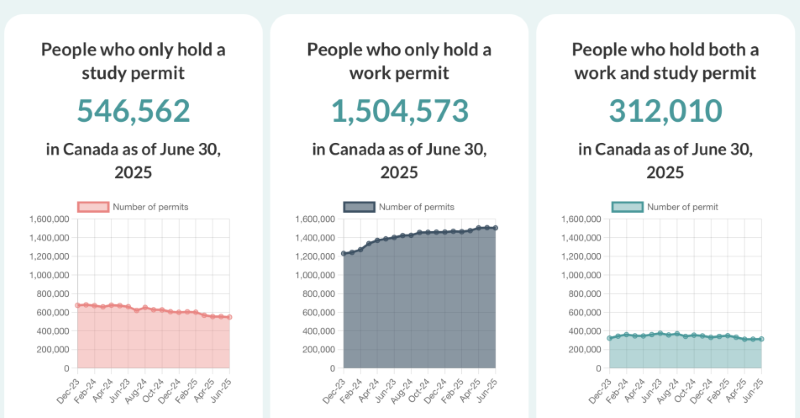#CanadaImmigration #InternationalStudents #TemporaryWorkers #HousingCrisis #CanadianEconomy #PolicyShift #WorkPermits #StudyPermits #LabourShortage #MigrationPolicy
Ottawa: Canada is witnessing a dramatic decline in the number of international students and temporary workers entering the country, reflecting the government’s strategic push to rebalance immigration and ease pressure on housing, infrastructure, and essential services.
Fresh data released up to June 30, 2025, shows a sharp drop of 214,520 arrivals compared to the same period last year. The fall is split between two categories: international students, down by 88,617, and temporary foreign workers, down by 125,903.
In June 2025 alone, Canada admitted just 4,185 new students and 24,058 temporary workers, underlining how quickly the immigration landscape is shifting under the government’s new framework.
Policy Backdrop: The 2025–2027 Immigration Levels Plan
The downturn in arrivals stems from the federal government’s Immigration Levels Plan 2025–2027, a roadmap designed to recalibrate the country’s intake of temporary residents.
The plan caps temporary resident targets at 673,650 for 2025, with further reductions to 516,600 in 2026, before a modest rise to 543,600 in 2027. By the end of this period, policymakers expect temporary residents to account for less than 5 percent of Canada’s population, down from the current 7.3 percent.
Finance Minister Mark Carney and Immigration Minister officials have emphasized that this controlled slowdown is aimed at ensuring “sustainable migration.” The focus is now on attracting individuals in sectors facing acute shortages, such as healthcare, trades, and agriculture, while easing the immediate strain on urban housing and public services.
International Students Under Tight Scrutiny
For international students—long considered an important pillar of Canada’s higher education system and a source of skilled workers—the environment has become far more challenging.
-
In 2024, Ottawa imposed caps on the number of new study permits.
-
In 2025, these caps were cut by an additional 10 percent, significantly reducing admissions.
-
Tighter rules on postgraduate work permits and spouse eligibility have further limited pathways for students seeking longer-term residency options.
As of mid-2025, 546,562 individuals hold study permits only, while 312,010 hold both study and work permits. Although more than 100,000 temporary residents transitioned to permanent residency in the first half of 2025, analysts suggest the new restrictions will slow this pipeline in coming years.
Temporary Workers Face Caps and Wage Hikes
On the labour front, Canada has rolled out a more stringent regime for temporary workers.
-
A 10 percent cap has been introduced on the number of low-wage hires that businesses can make, with a slightly higher 20 percent ceiling for in-demand industries.
-
A refusal-to-process rule now applies in regions where unemployment exceeds 6 percent, preventing new low-wage worker applications.
-
As of June 27, 2025, employers must meet higher wage thresholds to secure approvals for temporary foreign worker applications.
Despite these measures, 1,504,573 individuals still hold work permits only, underlining the vast scale of Canada’s temporary foreign workforce. However, the trajectory is clearly downward, aligning with government objectives.
Housing Market Impact
One of the most immediate and visible effects of the policy shift has been in the housing market.
For years, surging immigration contributed to rising demand in cities like Toronto, Vancouver, and Calgary, pushing rents and housing prices to record highs.
According to the Canada Mortgage and Housing Corporation (CMHC), rents in these markets have begun to stabilize and even ease slightly, as the outflow of temporary residents reduces demand. For policymakers under pressure to tackle housing affordability, this development is a crucial win.
Economic Risks: Labour Shortages Ahead
While the pullback has alleviated some housing pressures, economists and industry leaders warn of serious risks ahead.
Sectors such as healthcare, skilled trades, hospitality, and agriculture rely heavily on temporary migrants to fill critical roles. A sharp reduction in the availability of foreign workers could worsen existing labour shortages, particularly as Canada’s workforce ages.
Businesses have already flagged challenges in recruitment, warning that a shrinking temporary labour pool could disrupt operations and hinder growth. Healthcare providers, in particular, have expressed concern that staffing gaps could widen, affecting patient care and service delivery.
Balancing Act for Policymakers
The developments underscore the delicate balancing act facing Canadian policymakers. On one hand, reducing immigration inflows is helping ease urban housing stress and giving provinces and municipalities time to strengthen infrastructure and services. On the other hand, the cuts threaten to deprive businesses and essential sectors of much-needed workers.
Experts suggest the government’s strategy represents a shift toward quality over quantity in migration—focusing on those who can make long-term contributions rather than sustaining record-breaking inflows year after year.
“Canada is entering a new phase of immigration policy,” said Dr. Elaine Tremblay, a policy analyst at the Centre for Migration Studies. “The emphasis now is not just on how many people come in, but on how they fit into the country’s economic and social priorities.”
Looking Ahead
As the 2025–2027 plan unfolds, its impacts will be closely watched across sectors. Housing affordability may continue to improve, but labour market tightness could test the resilience of industries that depend on temporary residents.
For international students and workers, Canada remains an attractive destination—but one with stricter entry rules and fewer guarantees of permanent residency.
The broader question is whether this recalibration will strike the right balance between sustainability and growth, ensuring that Canada remains both competitive and livable in the years ahead.
🔑 Hashtags
#CanadaImmigration #InternationalStudents #TemporaryWorkers #HousingCrisis #CanadianEconomy #PolicyShift #WorkPermits #StudyPermits #LabourShortage #MigrationPolicy

